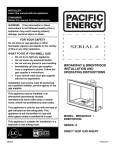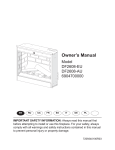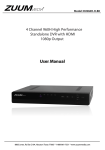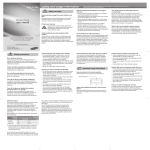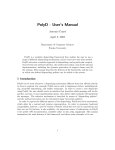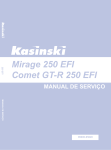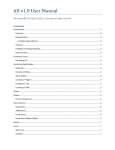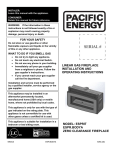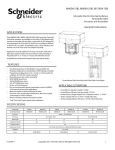Download mirage manual pdf - The Chimney Sweep Online
Transcript
INSTALER: Leave this manual with the appliance. CONSUMER: Retain this manual for future reference. WARNING: If the information in these instructions is not followed exactly a fire or explosion may result causing property damage, personal injury or death. FOR YOUR SAFETY Do not store or use gasoline or other flammable vapours and liquids in the vicinity of this or any other appliance. WHAT TO DO IF YOU SMELL GAS x x x x x Do not try to light any appliance. Do not touch any electrical switch. Do not use any phone in your building. Immediately call your gas supplier IURPDQHLJKERXU¶VSKRQH)ROORZWKH JDVVXSSOLHU¶VLQVWUXFWLRQV If you cannot reach your gas supplier call the fire department. MIRAGE INSTALLATION AND OPERATING INSTRUCTIONS Installation and service must be performed by a qualified installer, service agency or the gas supplier. This appliance may be installed in an aftermarket permanently located, manufacture home (USA only) or mobile home, where not prohibited by local codes. This appliance is only for use with the type of gas indicated on the rating plate. This appliance is not convertible for use with other gases unless a certified kit is used. This appliance is suitable for installation in a bedroom or bed sitting room. 122213 GMIR.BODYA MODEL: GMIR.BODYA FREESTANDING FIREPLACE 5055.61 Important Note for the Commonwealth of M assachusetts: From Massachusetts Rules and Regulations 248 CMR 5.08: (a) For all side wall horizontally vented gas fuelled equipment installed in every dwelling, building or structure used in whole or in part for residential purposes, including those owned or operated by the Commonwealth and where the side wall exhaust vent termination is less than seven (7) feet above finished grade in the area of the venting, including but not limited to decks and porches, the following requirements shall be satisfied. 1. INSTALLATION OF CARBON MONOXIDE DETECTORS. At the time of installation of the side wall horizontal vented gas fuelled equipment, the installing plumber or gas fitter shall observe that a hard wired carbon monoxide detector with an alarm and battery back-up is installed on the floor level where the gas equipment is to be installed, in addition, the installing plumber or gas fitter shall observe that a battery operated or hard-wired carbon monoxide detector with an alarm is installed on each additional level of the dwelling, building or structure served by the side wall horizontal vented gas fuelled equipment. It shall be the responsibility of the property owner to secure the services of qualified licensed professionals for the installation of hard-wired carbon monoxide detectors. a. In the event that the side wall horizontally vented gas fuelled equipment is installed in a crawl space or an attic, the hard-wired carbon monoxide detector with alarm and battery back-up may be installed on the next adjacent floor level. b. In the event that the requirements of this subdivision cannot be met at the time of completion of installation, the owner shall have a period of thirty (30) days to comply with the above requirements; provided, however, that during said thirty (30) day period, a battery operated carbon monoxide detector with an alarm shall be installed. 2. APPROVED CARBON MONOXIDE DETECTORS. Each carbon monoxide detector as required in accordance with the above provisions shall comply with NFPA 720 and be ANSI/UL 2034 listed as IAS certified. 3. SIGNAGE. A metal or plastic identification plate shall be permanently mounted to the exterior of the building at a minimum height of eight (8) feet above grade directly in line with the exhaust vent terminal for the horizontally vented gas fuelled heating appliance or equipment. The sign shall read, in print size no less than one-KDOI LQFKLQVL]H³*$69(17',5(&7/<%(/2:.((3&/($52)$//2%6758&7,216´ 4. INSPECTION. The state or local gas inspector of the side wall horizontally vented gas fuelled equipment shall not approve the installation unless, upon inspection, the inspector observes carbon monoxide detectors and signage installed in accordance with the provisions of 248 CMR 5.089(2)(a) 1 through 4. (b) EXEMPTIONS. The following equipment is exempt from 248 CMR 5.089(2)(a) 1 through 4. 1. 7KHHTXLSPHQWOLVWHGLQ&KDSWHUHQWLWOHG³(TXLSPHQW1RW5HTXLUHG7R%H9HQWHG´LQWKHPRVWFXUUHQWHGLWLRQRI1)3$DVDdopted by the Board; and 2. Product Approved side wall horizontal vented gas fuelled equipment installed in a room or structure separate from the dwelling, building or structure used in whole or in part for residential purposes. (c) MANUFACTURER REQUIREMENTS ± GAS EQUIPMENT VENTING SYSTEM PROVIDED. When the manufacturer of Product Approved side wall horizontally vented gas equipment provides a venting system design or venting system components with the equipment, the instructions provided by the manufacturer for installation of the equipment and the venting system shall include: 1. Detailed instructions for the installation of the venting system design or the venting system components; and 2. A complete parts list for the venting system design or venting system. (d) MANUFACTURER REQUIREMENTS ± GAS EQUIPMENT VENTING SYSTEM NOT PROVIDED. When the manufacturer of a Product Approved VLGHZDOOKRUL]RQWDOO\YHQWHGJDVIXHOOHGHTXLSPHQWGRHVQRWSURYLGHWKHSDUWVIRUYHQWLQJWKHIXHOJDVHVEXWLGHQWLILHV³VSHFLDOYHQWLQJV\VWHPV´WKHIROORZLQJ requirements shall be satisfied by the manufacturer. 1. 7KHUHIHUHQFHG³VSHFLDOYHQWLQJV\VWHP´LQVWUXFWLRQVVKDOOEHLQFOXGHGZLWKWKHDSSOLDQFHRUHTXLSPHQWLQVWDOODWLRQLQVWUXFWLRQVDQG 2. 7KH³VSHFLDOYHQWLQJV\VWHPV´VKDOOEH3URGXFW$SSURYHGE\WKH%RDUGDQGWKHLQVWUXFWLRQVIRUWKDWV\VWHPVKDOOLQFOXGHDSDrts list and detailed installation instructions. (e)) A copy of all installation instructions for all Product Approved side wall horizontally vented gas fuelled equipment, all venting instructions, all parts lists for venting instructions, and/or all venting design instructions shall remain with the appliance or equipment at the completion of the installation. 2 Table of Contents Caution 4 Safety 5 Owners Information First Fire 6 Remote Control Operation 7 Maintenance 13 Lighting Instructions 14 Installer information Fireplace Dimensions 15 Clearances to Combustibles 16 Locating the Fireplace 16 Venting 17 Plumbing and Electrical 19 Gas Supply 20 Gas Pressure Check 20 Gas Pressure Testing Procedure 21 Pilot Adjustment 21 Propane Conversion 22 Door Installation / Removal 23 Fan Installation/ Removal 23 Panel Installation/Removal 24 Burner Kit Installation/Removal 25 Glass Kit Installation 25 Log Set Installation 25 Venturi Adjustment 26 Cladding Installation/Removal 26 Replacement Parts 29 Aesthetic Options 29 Venting Components 30 Wiring Diagram 31 Installation Notes 32 0LUDJH5DWLQJ/DEHO««««««««««« 3 Caution FOR YOUR SAFETY - Do not install or operate your Pacific Energy gas fireplace without first reading and understanding this manual. Any installation or operational deviation from the following instructions voids the Pacific Energy Fireplace Products Warranty and may prove hazardous. This appliance and its individual shut off valve must be disconnected from gas supply piping system during any pressure testing of that system at test pressures in excess of 1/2 psi (3.5 kPa). This appliance must be isolated from the gas supply piping system by closing its individual manual shut off valve during any pressure testing of the gas supply piping system at test pressures equal to or less than 1/2 psi (3.5 kPa). Do not use the fireplace if any part has been under water. Immediately call a qualified service technician to inspect the fireplace and to replace any part of the control system and / or any gas control which has been under water. This fireplace is equipped with a micro mesh safety screen for your protection and must be installed with the unit. Removal of the safety screen will cause the fireplace to become a burn hazard. 4 Safety x Due to high temperatures, this gas appliance should be located out of traffic and away from furniture and draperies. x Children and adults should be alerted to the hazards of high surface temperatures and should stay away to avoid burns or clothing ignition. x Young children should be carefully supervised when they are in the same room as the appliance. Toddlers, young children and others may be susceptible to accidental contact burns. A physical barrier is recommended if there are at risk individuals in the house. To restrict access to a fireplace or stove, install an adjustable safety gate to keep toddlers, young children and other at risk individuals out of the room and away from hot surfaces. x Clothing or other flammable material should not be placed on or near the appliance. x A barrier designed for to reduce the risk of burns from the hot viewing glass is provided with the appliance and shall be installed. x If the barrier becomes damaged, the barrier shall be replaced with the manufacturers barrier for this appliance. x Any grill, panel or door removed for servicing the unit must be replaced prior to operating. x Installation and repair should be done by a qualified service person. The appliance should be inspected before use and at least annually by a professional service person. More frequent cleaning may be required due to excessive lint from carpeting, bedding material, etc. It is imperative that control compartments, burners and circulating air passageways of the appliance be kept clean. x This appliance must not be connected to a chimney flue serving a separate solid fuel burning appliance. x It is our policy that no responsibility is assumed by the Company or by any of its employees or representatives for any damages caused by an inoperable, inadequate, or unsafe condition which is the result, either directly or indirectly, of any improper operation or installation procedures. 5 2:1(5¶6 INFORMATION Congratulations on your purchase of a Pacific Energy Gas Fireplace. Your fireplace has been professionally installed by: Dealer name: ___________________ Phone Number: _________________ If you discover any problems with your gas fireplace contact your dealer immediately to have the unit repaired. Caution: Do not attempt to repair the fireplace because you may cause injury to yourself or other, and risk causing damage to the unit. Before operating your fireplace carefully read this manual and pay close attention to all Safety :DUQLQJV7KHPDQXDOFRQWDLQVLPSRUWDQWLQIRUPDWLRQRQWKHXQLW¶VVDIHRSHUDWLRQDQG maintenance. First Fire When lit for the first time, the fireplace will emit a slight odour for a couple of hours. This is due to the curing of paints, sealants, gaskets, and lubricants used in the manufacturing process. This condition is temporary. Open up doors and windows to ventilate the area. Odour caused by the curing process may cause discomfort to some individuals. It is normal for fireplaces fabricated from steel to give off some expansion and/or contraction noises during the start up or cool down cycle. Similar noises are found with your furnace heat exchanger or cook stove oven. 6 ` Remote Control Operation 2:1(5¶6 INFORMATION System Description The Proflame Remote Control System consists of two elements: 1. Proflame Transmitter. 2. Proflame Integrated Fireplace Control (IFC) board and a wiring harness to connect the IFC to the gas valve and stepper motor. Transmitter (Remote Control with LCD Display) The Proflame Transmitter uses a streamline design with a simple button layout and informative LCD display (Figure 1). The transmitter is powered by 3 AAA type batteries. A mode key is provided to index between the features and a thermostat key is used to turn on/off or index through thermostat functions (Figure 1 & Figure 2). Figure 1: Proflame Transmitter Figure 2: Transmitter LCD display 7 2:1(5¶6 INFORMATION IFC Module The Proflame 2 Integrated Fireplace Control (IFC) board is a device that allows the automatic ignition and pilot flame supervision, to command the functions of a hearth appliance. ,W¶V configured to control the ON/OFF main burner operation, giving the choice of both IPI (intermittent pilot ignition), and CPI (continuous pilot ignition) modes. The Proflame 2 IFC board controls and connects directly to the pilot assembly and an automatic valve of the Proflame 880, 886 and 885 families using low electric power. The IFC Board can be powered by an AC and battery pack for back up (ATMO Systems only). The Proflame 2 offers the added ability to control the comfort fan speed from OFF through six (6) speeds, a remotely actuated auxiliary outlet and a dimmable light outlet. The external batteries can provide DC power to the IFC allowing the batteries to be used only when line power is interrupted or lost, and if the appliance does not use a combustion fan. OPERATING PROCEDURE Initializing the System for the first time Install the 4 AA batteries into the battery bay. Note the polarity of the battery and insert into the battery holder as indicated on the battery cover (+/-). Set the main ON/OFF and the CPI/IPI switch LQWKHFORVHGSRVLWLRQ3UHVVWKH6:EXWWRQRQWKH,)&PRGXOH7KH,)&ZLOO³EHHS´WKUHH WLPHV to indicate that it is ready to synchronize with a transmitter. Install the 3 AAA type batteries in the battery bay, located on the base of the transmitter. With the batteries already installed in the transmitter, push the ON button. The rHFHLYHUZLOO³EHHS´IRXUWLPHVWRLQGLFDWHWKHWUDQVPLWWHU¶V command is accepted. If a second Transmitter must be registered it can be turned ON. The receiver will beep again four (4) times and exit the synchronization phase. If only one transmitter is used, then press the button SW1 to exit the synchronization phase. The system is now initialized. 8 2:1(5¶6 INFORMATION Temperature indication Display With the system in WKH³2))´SRVLWLRQSUHVVWKHWKHUPRVWDWNH\DQGWKH mode key at the same time. Look at the LCD screen on the transmitter to verify that a C or F is visible to the right of the room temperature display. (Figure 3 & Figure 4) Turn on the Appliance First close the main ON/OFF switch on the wirings. With the system OFF, press the ON/OFF Key on the transmitter. The transmitter display will show all active icons on the screen. At the same time IFC will be commanded to start the ignition process. Once the pilot flame is proven the IFC board will open the main valve outlet and the appliance main burner will also ignite. A VLQJOH³EHHS´IURPWKH,)&PRGXOHZLOOFRQILUPUHFHSWLRQRf the command. Turn off the Appliance With the system ON, press the ON/OFF key on the transmitter. The transmitter LCD display will only show the room temperature. At the same time the IFC will be commanded to turn off the burner. Depending on the system mode (IPI or CPI) the pilot may shut off (IPI) or remain lit (CPI) and the appliance burner turns 2))$VLQJOH³EHHS´IURPWKHUeceiver confirms reception of the command. Figure 3: Display in Fahrenheit Figure 4: Display in Celsius Manual Bypass of the Remote System If the batteries of the receiver or transmitter are low or depleted, the appliance can be turned off manually using switch located on battery box. This will bypass the remote control feature of the system. Key Lock This function will lock the keys to avoid unsupervised operation. To activate this function, press the MODE and UP keys at the same time (Figure 5). To de-activate this function, press the MODE and UP keys at the same time. Figure 5 9 2:1(5¶6 INFORMATION Remote Flame Control The Proflame has six (6) flame levels. With the system on, and the flame level at the maximum in the appliance, pressing the down arrow key once will reduce the flame height by one step until the flame is turned off. The up arrow key will increase the flame height each time it is pressed. If the up arrow key is pressed while the system is on but the flame is off, the flame will come on in the high position. (Figure 6) $VLQJOH³EHHS´ will confirm reception of the command. Figure 6 ROOM THERMOSTAT (Transmitter Operation) The remote control can operate as a room thermostat. The thermostat can be set to a desired temperature to control the comfort level in a room. To activate this function, press the thermostat key (Figure 1). The LCD display on the transmitter will change to show that the room thermostat is ³21´DQGWKHVHWWHPperature is now displayed (Figure 7). To adjust the set point, press the up or down arrow keys until the desired set point temperature is displayed on the LCD screen of the transmitter. Figure 7 Smart Thermostat (Transmitter Operation) The Smart Thermostat function adjusts the flame height in accordance to the difference between the set point and the room temperatures. As the room temperature gets closer to the set point the Smart Function will modulate the flame down. If the room temperature is cool the Smart Function will modulate the flame up. To activate this function, press the THERMOSTAT key (Figure 1) until the word "SMART" appears to the right of the temperature bulb graphic (Figure 8). To adjust the set point, press the up or down arrow keys until the desired set point temperature is displayed on the LCD screen of the transmitter (Figure 9). Figure 8: Smart Flame Function Figure 9 10 2:1(5¶6 INFORMATION Comfort Fan Speed Control If the appliance is equipped with a hot air circulating fan, the speed of the fan can be controlled by the Proflame System. The fan speed can be adjusted through six (6) speeds. To activate this function use the Mode Key (Figure 1) to index to the fan control icon (Figure 10). Use the Up/Down Arrow Keys (Figure 1) to turn on, off or adjust the fan speed (Figure 10 $VLQJOH³EHHS´ZLOOFRQILUPUHFHSWLRQRIWKHFRPPDQG Figure 10: Fan Control Continuous Pilot/Intermittent Pilot (CPI/IPI) selection With the system in "OFF" position press the Mode Key (Figure 1) to index to the CPI mode icon (Figure 11). Pressing the Up Arrow Key will activate the Continuous Pilot Ignition mode (CPI). Pressing the 'RZQ$UURZ.H\ZLOOUHWXUQWR,3,$VLQJOH³EHHS´ZLOOFRQILUPWKHUHFHSWLRQRIWKH command. Figure 11: CPI/IPI Selection 11 2:1(5¶6 INFORMATION Low Battery Power Detection Transmitter The life span of the remote control batteries depends on various factors: quality of the batteries used, the number of ignitions of the appliance, the number of changes to the room thermostat set point, etc. When the transmitter batteries are low, an icon will appear on the LCD display of the transmitter (Figure 12) before all battery power is lost. When the batteries are replaced this icon will disappear. Figure 12 Receiver The life span of the IFC batteries depends on various factors: quality of the batteries used, the number of ignitions of the appliance, the number of changes to the room thermostat set point, etc. When the IFC batteries are low, a "double-EHHS´ZLOOEHHPLWWHGIURPWKH,)&ERDUGZKHQLW receives a command from the transmitter. This is an alert for a low battery condition for the IFC ERDUG:KHQWKHEDWWHULHVDUHUHSODFHGWKH³EHHS´ZLOOEHHPLWWHGIURPWKH,)&ERDUGZKHQD key is pressed (See Initialization of The System). Warnings and Cautions WARNING Fire Hazard. Can cause severe injury or death The Receiver causes ignition of the appliance. The appliance can turn on suddenly. Keep away from the appliance burner when operating the remote system or activating manual bypass of the remote system. WARNING Shock Hazard. Can cause severe injury or death This device is powered by line voltage. Do not try to repair this device. In no way is the enclosure to be tampered with or opened. Disconnect from line voltage before performing any maintenance. 12 Maintenance 2:1(5¶6 INFORMATION Turn off gas and electrical power supply (if applicable) and allow ample time for unit to cool before servicing appliance. It is recommended that the fireplace and its venting should be inspected at least once a year by a qualified service person. Glass Door: Warning: Do not operate fireplace with glass door removed, cracked or broken. Replacement of the glass door should be done by a licensed or qualified service person. Do not strike or otherwise impact the glass in any way that may cause it to break. If the glass becomes cracked or broken it must be replaced before using the fireplace. Replacement door can be obtained from your nearest Pacific Energy dealer. Do not substitute with any other type. To remove broken glass, remove door as noted in "Door Removal" section. Annual Inspection: a) Remove glass door and decorative media (such as logs and rocks). Inspect decorative media and burner assemblies for soot buildup. If excessive buildup of soot is present, have a qualified service person inspect and adjust unit for proper combustion. Clean burners with a brush or vacuum cleaner, paying close attention to burner ports. b) Check the pilot system for proper flame size and operation. Clean pilot free of soot, dust or any other deposits. c) Check that the vent pipe and vent terminal are open and free from blockage or debris. If the venting is disassembled for cleaning, it must be properly assembled and re-sealed. Refer to VENTING section for proper procedure. d) Check glass panel gasket, replace if necessary. It is important that the glass seal be maintained in good condition. e) Check and replace batteries as needed. Note: The appliance area must be kept clear and free from combustible materials, gasoline and other flammable vapors and liquids. Periodically: a) Viewing glass may be cleaned as necessary with fireplace glass cleaner. b) Exterior finish may be cleaned with mild soap and water. CAUTION: Do not use abrasive cleaners on glass or any other part of the fireplace. Do not clean glass when hot. 13 2:1(5¶6 INFORMATION Lighting Instructions 14 Fireplace Dimensions INSTALLER INFORMATION MIRAGE: Figure 13: Fireplace dimensions 15 INSTALLER INFORMATION Clearances to Combustibles Minimum Clearance to Combustible Materials Mirage INTERIOR SIDE WALL ϰ͟ INTERIOR BACK WALL ϰ͞ INTERIOR CEILING ϰ͟ IN FRONT OF APPLIANCE ϯϲ͟ EXTERIOR SIDE WALL ϴ͟ VENTING CLEARANCE ϭ͟ EXTERIOR SOFFIT ϯϬ͟ *NCR STANDS FOR NO CLEARANCE REQUIRED; YOU MAY USE COMBUSTIBLE CONSTRUCTION MATERIALS IN DIRECT CONTACT WITH THE APPLIANCE ON THESE SURFACES. Figure 14: Minimum Clearances Locating the Fireplace In planning the installation for the fireplace, it is necessary to determine where the unit is to be installed, location of vent system and where gas supply piping may be plumbed. Various installations are possible, such as next to an existing wall, a corner, an alcove or a wall projection. Due to high temperatures, do not locate this fireplace in areas of high traffic, near furniture or draperies. Figure 13: Common Installation Location 16 INSTALLER INFORMATION Venting Note: The vent must not exceed a total length of 28 feet. Any combination of rise and run may be used but must be constrained to the boundaries of this chart. A Maximum of three (3) 90° elbows may be used. Only one (1) 90° elbow or combination of other elbows equalling 90° can be used without reducing horizontal run. For each additional 90° elbow, or an equal combination of elbows, reduce horizontal vent run by 2 feet. Ensure vent pipe is properly supported. 17 INSTALLER INFORMATION Figure 17: Venting dŚŝƐĨŝƌĞƉůĂĐĞŝƐĐĞƌƚŝĨŝĞĚĨŽƌƵƐĞǁŝƚŚϰ͟džϲ-‐ϱͬϴ͟ĐŽĂdžŝĂůǀĞŶƚŝŶŐĐŽŵƉŽŶĞŶƚƐŽŶůLJ͘/ƚŝƐƉĞƌŵŝƚƚĞĚƚŽŽŶůLJƵƐĞ certified venting for this appliance. See charts on page 30 for a list of approved venting components. 18 INSTALLER INFORMATION Plumbing and Electrical Figure 14: Gas and Electrical Connections Gas connection To make the required electrical and gas connections, start by positioning the gas fireplace. Connect the gas supply line to the 1/2´flare fitting at the rear of the unit as seen in Figure 14. Please see the gas supply section of the manual for requirements of the gas supply. Electrical connection Plug the provided IEC power cord into the receptacle at the rear of the unit as shown in Figure 14. 19 INSTALLER INFORMATION Gas Supply Servicing of the appliance can be performed from the rear of the unit by removing the access panel from the unit. Caution: The gas line should be installed by a qualified service person in accordance with all building codes. This section is intended as a guide for qualified technicians installing this appliance. Consult local and/or national building codes before proceeding. x x x Gas supply line connection is located on the rear of the fireplace. Gas connection accepts a ò´IODUHILWWLQJ&RUUHFWJDVOLQHGLDPHWHUPXVWEHXVHGWRDVVXUHSURSHURSHUDWLRQDQG pressure. The fireplace input rating is shown in the chart below. x A drip leg must be installed in the gas supply line going to the gas control valve to -minimize the possibility of any loose scale or dirt within the gas supply line from -entering the control valve. x It is essential that a union or flanged connection be installed just upstream of the valve to allow for repair or replacement of the gas valve. Check local codes for additional requirements. Turn on the gas supply and check that all connections are tight and leak free. WARNING: The gas tray including gasket must be reinstalled after conversion/installation or servicing has been completed. Gas Pressure Check Please refer to following page for gas pressure testing procedure. Gas pressure requirements Mirage Input Pressure Natural Gas Propane Minimum Maximum 4.0" WC 13.9" WC 11.0" WC 13.9" WC 3.5" WC 1.6" WC 10" WC 6.4" WC Manifold Pressure High Low 20 Gas NG LP Orifice Output 1.98mm 18,000 btu/hr 1.25mm 18,000 btu/hr AFUE 72% 72% Gas Pressure Testing Procedure INSTALLER INFORMATION Note: To test the gas pressure, turn off the gas supply to the appliance before loosening test point screws. Verify gas pressures with the fireplace lit and at the highest setting. 1. Remove back panel and locate the valve as seen in Figure 15. 2. Locate the inlet and outlet test points on the valve which can be seen in Figure 16. After locating test ports loosen the screws within the ports using a flat-tip screwdriver. 3. Attach pressure gauge to the test ports. 4. Turn gas supply back on and test pressures. 5. After testing is finished turn off gas supply, remove the pressure gauges and retighten the screws in the test points. Pilot Adjustment The pilot flame level can be adjusted by turning the adjustment screw, using a flat-tip screwdriver, seen on the valve in Figure 16. Figure 15: Valve Location Figure 16: Valve 21 INSTALLER INFORMATION Propane Conversion Before starting the conversion make sure to shut off the gas supply to the unit and allow fireplace to cool to room temperature. To convert the gas fireplace insert from natural gas to propane the (GASC.LPKIT) kit is required. This kit comes with new pilot and burner orifices as well as a new pressure modulator for the valve. To switch the pressure modulator, follow the instructions that are provided with the conversion kit. Figure 17: Pilot To change the orifices you are required to remove the door, and side cladding. Please refer to the appropriate sections of this manual and follow instructions on how to correctly remove the components. After removing the side cladding you will have access to the burner orifice¶VPRXQWLQJSODWH on right side of unit. To access the orifice remove the two nuts securing the mounting plate and pull from side of unit, as seen in Figure 17. The orifice can be UHPRYHGXVLQJDò´VRFNHW%HIRUHLQVWDOOLQJWKHQHZRULILFH Loctite 567 Thread Sealant needs to be applied to the threads of the new orifice to ensure a proper seal when installed. To replace the pilot orifice you will need to remove the pilot hood which is held in place by a spring. First remove the spring, and then remove the hood by pulling it up from the pilot bracket, seen in Figure 187RUHPRYHWKHH[LVWLQJRULILFHLQVHUWD´RU 4mm Allen wrench into the hexagonal key-way of the orifice and rotate counter-clockwise until free. Insert the new orifice using the same Allen wrench and tighten it until a torque of 9 lbf in (1 Nm) is achieved. Replace the pilot hood by aligning the tab on the base of the hood with the slot in the side of the pilot journal, and push the hood down onto the pilot bracket. Replace the spring by pushing it onto its seat. Figure 18: Pilot Before reinstalling the Cladding, the venturi shutter will have to be adjusted to the correct opening. Please refer to page 26 for correct adjustment of venturi. Figure 19: Orifice 22 INSTALLER INFORMATION Door Installation/Removal Installation 1. Position the JODVVUHWDLQHU¶VIUDPHVR that the studs on unit align with holes in frame. Secure using 12 ´QXWV as shown in Figure 20. CAUTION: Over tightening of nuts could result in glass fracturing. 2. Insert and lower the outer door by SRVLWLRQLQJWKHGRRU¶VSLQVLQWRWKHVOLWV in the firebox frame as shown in Figure 21. Removal 1. Lift the outer door up and pull away from unit. 2. Remove the 12 ´QXWV as shown in Figure 20. Carefully remove the glass retainer with the glass by tilting the top towards you. Figure 20: Glass Retainer Figure 21: Outer Door Fan Installation / Removal Installation 1. Connect wiring to the fan and insert into the fireplace through the side of the unit. 2. Insert both screws into the fan access panel to attach the fan to the unit, as in Figure 22. 3. Replace side surround as shown on page 26. Figure 22: Fan Instal/Removal Removal 1. Start by turning off the main gas supply to fireplace and disconnect the gas supply from the ´ flare fitting as seen in Figure 14. Also, disconnect the power cord from the unit. 2. Pull the fireplace insert out of the pre-existing fireplace cavity until the cladding on the right side of the fireplace can be accessed. Remove the top and side cladding. 3. Remove the two (2) screws from the panel as shown in Figure 22 and pull the fan out of unit. You will have to disconnect the wires from the fan before you can remove it completely. 23 INSTALLER INFORMATION Panel Installation / Removal Note: The burner tray needs to be removed before installation or removal of panels, see page 25. Installation 1. Insert lower back panel so that it is sitting on the ledge at the back of the firebox as shown in Figure 23. 2. Insert upper back panel so that it is sitting on top of the lower back panel as shown in Figure 266. 3. Insert first side panel by tilting the panel into the fire box chamber. Then slide the panel until it reaches the firebox side wall. See Figure 25. 4. Repeat step 3 for the second side panel. Figure 24: Panel Set Removal 1. Remove first side panel by pulling the bottom edge of panel into the firebox chamber until there is enough room to move the panel away from the wall. When you have enough room remove the panel from the fireplace. 2. Repeat step 1 to remove second side panel. 3. Remove the upper back panel by tilting the top forward and then pull out of fireplace. 4. Remove the lower back panel by lifting it off of the pilot ledge and the pull out of fireplace. Figure 266: Upper Back Panel Figure 25: Side Panel Figure 23: Lower Back Panel 24 Burner Kit Installation / Removal INSTALLER INFORMATION Burner Tray Installation / Removal Installation Place the burner tray in the firebox so that the venturi is over top of the orifice. To secure the burner tray, insert the 4 screws using a screwdriver, as seen in Figure 27. Removal Remove the 4 screws seen in Figure 27 using a screwdriver, and remove the burner tray. Figure 27: Burner Tray Glass Kit Installation To install the glass, evenly spread a thin layer of crushed glass across the entire burner pan as seen in Figure 28. Figure 28: Glass Installation Log Set Installation 1. 2. 3. 4. Position rear log against the back firebox as seen in pane 1 of Figure 29. Interlock right log with rear log as seen in pane 2. Lean left log against log set as seen in pane 3. Interlock front log with left log to complete log set structure. Note: Do Not Block Pilot With Logs Figure 29: Log Set Installation 25 INSTALLER INFORMATION Venturi Adjustment To adjust the venturi the lower front piece of cladding needs to be removed, please refer to appropriate section of manual for removal instructions. With the lower front cladding removed you are able to reach the venturi adjustment rod seen in Figure 30. See Table for Rod Position. Gas Natural (NG) Propane (LP) Adjustment Rod Venturi Full Down 1/8 Open Full Up Full Open Venturi Adjustment Table Figure 30: Venturi Adjustment Rod Cladding Installation / Removal Installation 1. Slide back the top cladding piece into the top of the fireplace as seen in Error! Reference source not found.. Fasten using screws on front of fireplace as shown in Error! Reference source not found.. 2. Place metal grill onto lower front cladding as seen in Error! Reference source not found.. 3. Place lower front cladding through the screw holes and secure screw nut onto the back of the cladding bolt as shown in Figure 33 & Figure 35. 4. Repeat step 3 for upper front cladding. 5. Secure side cladding stand using bolts as shown in Figure 34. 6. Slide front side of left side cladding into front clamps as shown in Figure 37. Secure back with hex bolts as shown in Error! Reference source not found.. 7. Repeat step 6 for the right side cladding. Figure 30: Top Cladding Screws 26 Figure 31: Top Cladding INSTALLER INFORMATION Figure 33: Lower Front Cladding Figure 32: Metal Grill Attachment Figure 35: Front Cladding Securement Figure 34: Side Cladding Stand 27 INSTALLER INFORMATION Figure 36: Side Cladding Securement Figure 37: Side Cladding Removal 1. 2. 3. 4. 5. 6. Unscrew hex bolts on back of fireplace and slide-out side cladding. Repeat step 2 for the cladding on the other side. Unscrew and remove side cladding stands. Unscrew bolts behind front upper cladding and remove cladding. Repeat step 4 for the front lower cladding. Unscrew top cladding screws then slide out and remove upper cladding. Note: If you are removing the cladding to adjust the venturi, skip steps 3, 4, and 6. 28 INSTALLER INFORMATION Replacement Parts Description 1. 2. 3. 4. 5. 6. 7. 8. 9. 10. Order Number Replacement Control Module Replacement Gas Valve Replacement Pilot Assembly Replacement Remote Control Replacement Complete Gas Tray Replacement Blower Kit Replacement Burner Replacement Door Glass Replacement Door Screen Replacement Aluker Panel Set GASC.MODA GASC.VALVEA GASC.PILOTA GASC.CNTRLA GMIR.3801 GMIR.3803 GMIR.3804 GMIR.3807 GMIR.5002.50 GMIR.5099.G958 Aesthetic Components Description Order Number Exterior Ceramic Panels by Piazzetta Mirage Surround Classic Bordeaux Mirage Surround Classic Oriental Sand Mirage Surround Classic Off White Mirage Surround Modern Stone Mirage Surround Modern Yellow Mirage Surround Modern Aqua Marine PZSY.P958CBX PZSY.P958COS PZSY.P958CWH PZSY.P958MST PZSY.P958YW PZSY.P958AM Optional Components Drift Wood Log Set Black Glass Copper Glass White Glass Blue Glass Propane Conversion Kit GMIR.5094.2305 GASC.15GLBK GASC.15GLBE GASC.15GLTW GASC.15GLPE GASC.LPKIT 29 INSTALLER INFORMATION Venting Components NOTE: Mixing venting components from different manufacturers is inadvisable. Figure 38´[-5/8" Rigid Piping Cross Reference Chart Figure 39: ´[-5/8" Rigid Pipe Components Cross Reference Chart 30 Wiring Diagram INSTALLER INFORMATION Caution: Label all wires prior to disconnection when servicing controls. Wiring errors can cause improper and dangerous operation. Verify proper operation after servicing. 31 INSTALLER INFORMATION Installation Notes NOTES: __________________________________________________________________________________________________ __________________________________________________________________________________________________ __________________________________________________________________________________________________ __________________________________________________________________________________________________ __________________________________________________________________________________________________ __________________________________________________________________________________________________ __________________________________________________________________________________________________ __________________________________________________________________________________________________ __________________________________________________________________________________________________ __________________________________________________________________________________________________ __________________________________________________________________________________________________ __________________________________________________________________________________________________ __________________________________________________________________________________________________ __________________________________________________________________________________________________ __________________________________________________________________________________________________ __________________________________________________________________________________________________ __________________________________________________________________________________________________ __________________________________________________________________________________________________ __________________________________________________________________________________________________ __________________________________________________________________________________________________ __________________________________________________________________________________________________ __________________________________________________________________________________________________ __________________________________________________________________________________________________ __________________________________________________________________________________________________ __________________________________________________________________________________________________ __________________________________________________________________________________________________ __________________________________________________________________________________________________ __________________________________________________________________________________________________ __________________________________________________________________________________________________ __________________________________________________________________________________________________ __________________________________________________________________________________________________ __________________________________________________________________________________________________ __________________________________________________________________________________________________ __________________________________________________________________________________________________ __________________________________________________________________________________________________ __________________________________________________________________________________________________ __________________________________________________________________________________________________ __________________________________________________________________________________________________ 32 INSTALLER INFORMATION 33 INSTALLER INFORMATION 34 INSTALLER INFORMATION 35






































